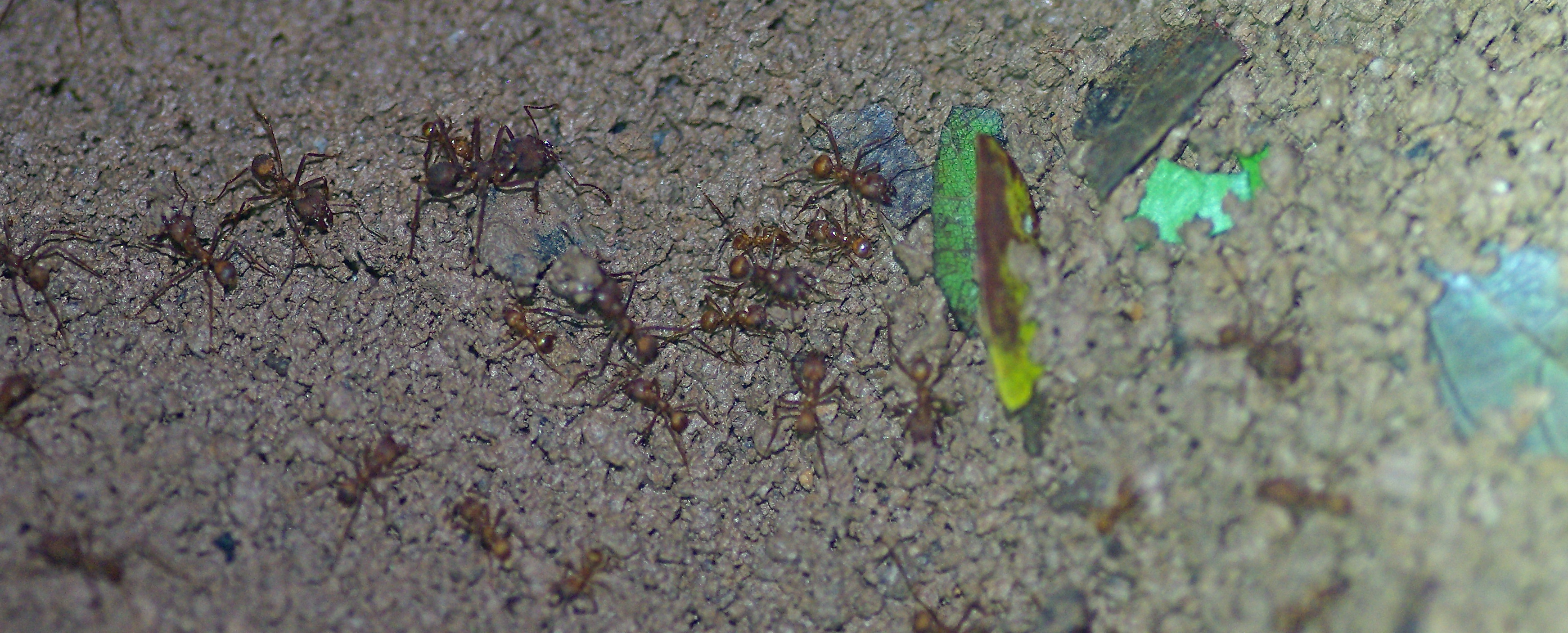You get used to it. Walking about on a mossy, wet trail (the equivalent of a sidewalk at the field station) you encounter a diagonal line of little bits of leaves, sticks and fragments of flowers crossing the path in front of you. They move jerkily but unwavering, going from the source—a tree or shrub that can be dozens of feet away—to the inconspicuous entrance to their massive subterranean labyrinth. There, the leaves and flowers and other organic mater will be chewed, mushed and tenderly placed on a special chamber to serve as the growing bed of a nutritious fungus, the ants main source of food. You step over them carefully and hope everyone, all those busy researchers, students, staff, cleaning crews and others also see them and avoid squashing them too.
In the forest, you walk with a similar care, at least I do. I watch where I step, avoiding branches that snap and make sharp cracking noises, give berth to solitary ants that roam through the leaf litter or the inconspicuous insect whose defense is to stay still to avoid detection; or even the very conspicuous frog, strawberry red and azure blue, that moves in the nick of time as your foot heads towards it. Life abounds, crawls, slithers and rests in every crevice, nook, cranny and pocket, and it is up to you to interact with it gently and with care.
Deep in the forest, the places we leave our literal footprints are even more important, lest you step on something that bites you back or gets permanently harmed by our substantial biomass. You avoid the tender seedlings struggling in deadly competition for the meager sunlight that barely reaches the forest floor; watch for the splashes of delicate tiny fungi, like small gray buttons balancing on wire-thin stems; anticipate the small salamander or frog that rests under a small pile of leaves, never knowing how close you could have come from squashing it. At night, the light of your flashlight illuminates a square foot of surface at a time, wavering, searching, not lingering at any spot for more than a second, until it encounters a reflection, an eye-shine, an anomaly. Then it focuses its harsh beam to allow our meager night vision to define what we could only briefly decipher.
I watch for these things when I’m in the forest. I swerve around seedlings for they may one day become the giants of the forest; I dodge the large hanging palm leaves for they may be the shelter to a wasp nest or a small colony of snowy-white bats; I step over a rotting log for I know it harbors a small world of interacting creatures. I’m retraining my eyes to see again, to decipher and resolve, to focus and distinguish what I once knew by heart but is now semi-lost in the recesses of my memories. The large immersive blob of green ad brown biomass that greets the first-time visitor to the tropical forest slowly comes into focus with recurrent exposure. With time, the details become clearer like a lifting fog, your eyes adjusting, sending better and better signals to your brain which accumulates, sorts and catalogs your sights. Your ears become attuned to the sounds, their direction and their source. Smells become names, shapes become species, colors become warnings or attractants, movement is focused on instantly. Your peripheral vision expands and sharpens, and eventually, often taking oh so long, you become a naturalist, a person that can recognize and visualize what is invisible to most other people. You master a new language made out of sounds, shapes, colors, scents and textures, and this language spills volumes of information into the canvas of the primary forest. Learning this language can take a lifetime, but how much wiser we become once we master the native tongue of the forest.
Carlos


Recent Comments